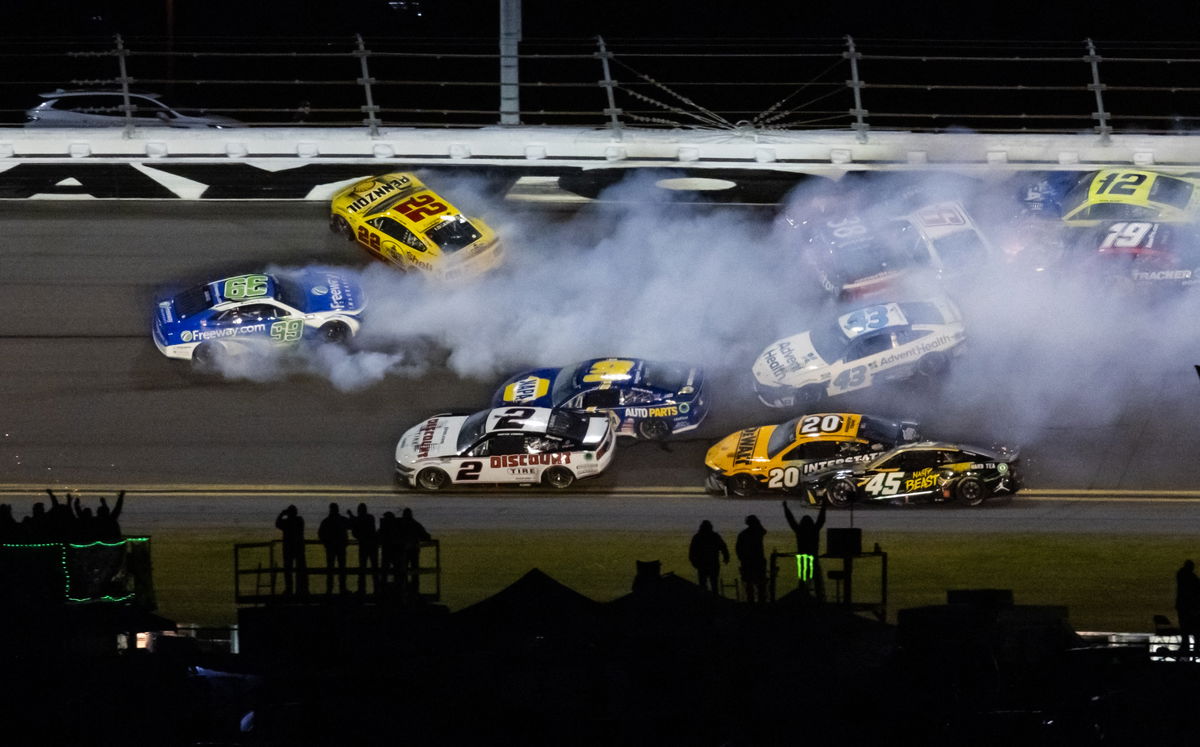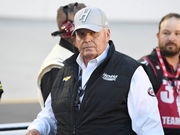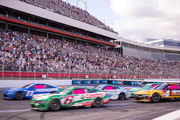
USA Today via Reuters
Feb 19, 2024; Daytona Beach, Florida, USA; NASCAR Cup Series drivers Austin Cindric (2), Chase Elliott (9) go low to avoid the crashing cars of Joey Logano (22), Daniel Suarez (99), Todd Gilliland (38), Brad Keselowski (6), Martin Truex Jr (19) and Ryan Blaney (12) during the Daytona 500 at Daytona International Speedway. Mandatory Credit: Mark J. Rebilas-USA TODAY Sports

USA Today via Reuters
Feb 19, 2024; Daytona Beach, Florida, USA; NASCAR Cup Series drivers Austin Cindric (2), Chase Elliott (9) go low to avoid the crashing cars of Joey Logano (22), Daniel Suarez (99), Todd Gilliland (38), Brad Keselowski (6), Martin Truex Jr (19) and Ryan Blaney (12) during the Daytona 500 at Daytona International Speedway. Mandatory Credit: Mark J. Rebilas-USA TODAY Sports
NASCAR races are known for their heart-pounding speed and dramatic finishes, but it is often the moments immediately after the checkered flag that hold unexpected tension. As drivers transition from fierce competition to celebration, the arena becomes a complex web of activity media crews capturing every angle, teams preparing for technical checks, and fans witnessing the triumphs and commotion. For all the adrenaline on the track, there is a quieter, ever-present challenge in managing safety during these post-race moments.
Watch What’s Trending Now!
Recent events have drawn attention to how quickly that balance can shift, reminding the racing world that while the race may be over, the risks sometimes linger long after the final lap. One such risky incident almost took place at the Gateway Xfinity race, involving the race winner.
ADVERTISEMENT
Connor Zilisch’s narrow escape after the NASCAR race
Connor Zilisch, a promising young talent in NASCAR known for his remarkable pace and skill, had just secured his 10th career victory and ninth of the season at the World Wide Technology Raceway when the post-race celebration nearly turned tragic. During his burnout routine en route to Victory Lane, Zilisch narrowly missed colliding with a cameraman positioned dangerously close to the track, a moment captured on video that quickly dominated headlines and social media, fueling renewed debate about NASCAR’s post-race safety protocols.
NASCAR events are high-stakes not only during the race but also immediately afterward, with drivers, crew members, media personnel, and officials all converging in a confined space. While the spotlight is on the winner, behind the scenes, risks persist. In recent years, NASCAR has reported over 100 accidents involving drivers during race weekends, with some drivers averaging crashes in nearly a quarter to a third of races entered. Though many incidents occur on-track, the post-race environment poses unique hazards that often receive less attention but carry significant danger, especially for non-drivers like camera operators.
Freddie Kraft underscored the broader perspective, noting, “Yikes. This kid’s gotta stop winning. Nothing good comes from it.” Their statements emphasize how unpredictable and hazardous post-race celebrations can be for all involved. Historically, NASCAR’s focus has been on driver safety during the race itself, that have dramatically reduced fatalities and serious injuries. However, statistics on incidents involving media personnel or crew members in post-race settings are more sparse, suggesting a gap in safety oversight in these moments where traffic flow is less predictable, and high energy meets proximity.
ADVERTISEMENT
Yikes. This kids gotta stop winning.
Nothing good comes from it. 😁 https://t.co/dyyj7W17dD
— Freddie Kraft (@FreddieKraft) September 7, 2025
Zilisch’s near-miss serves as a stark reminder that post-race operations require renewed attention. Camera crews positioned for dramatic footage often risk exposure to live vehicles during unpredictable driver maneuvers, such as celebrations or technical inspections. Many within the community now advocate for adopting alternatives such as drone technology or establishing physical barriers and no-go zones during post-race protocols to mitigate these risks.
ADVERTISEMENT
With Zilisch’s incident fresh in public memory, the racing world faces pressing questions: Can NASCAR adapt its operations to better protect all personnel during and after races? Will the sport embrace new technologies and revise protocols to prevent future near-tragedies? As fans, drivers, and officials debate these issues, the need for comprehensive post-race safety strategies has never been clearer.
Top Stories
Rick Hendrick Strikes Fear in NASCAR Fans With Chevy’s New “Illegal” Car

New Charter Deal Triggers ‘Financial Frenzy’ as NASCAR Teams Set for Massive Payday

Martin Truex Jr’s Former Crew Chief Ends 12-Year Fight In Huge Personal Announcement

Denny Hamlin Gloats as Jim France Forced to Eat His Words Against Rick Hendrick & Co.

Major Blow to Trackhouse Racing as Team Penske Steals Veteran Crew Chief Back in Unexpected Move

Furious fans with mixed reactions after the NASCAR race
The incident involving Connor Zilisch and the cameraman sparked a strong wave of reactions from the NASCAR fan base, with many expressing frustration and calling for stricter safety measures during post-race moments. Fans highlighted the precarious positioning of media personnel on the track during what should be controlled celebrations. One user bluntly warned, “I’m telling ya these camera men are eventually gonna get hit by a car, they need to use drones or stay behind the wall”. This sentiment echoed a broader concern that while drivers undergo rigorous safety standards, support staff and media crews remain vulnerable.
ADVERTISEMENT
Sarcasm and criticism were prevalent, with comments like “Gotta hit the wall to pass tech /s” pointing to the perceived casual attitude toward dangers around technical inspections and post-race procedures. Others questioned why cameramen weren’t sheltered behind barriers, noting, “So what and the camera man should be behind barrier that’s what a zoom is for,” advocating for more use of technology to minimize risk exposure.
Critics also underscored inconsistencies in NASCAR’s safety priorities. One fan remarked, “NASCAR claims they care so much about safety and so many things are banned, yet they let the camera people be put at risk of getting hit by a car during celebration. Makes sense,” highlighting a frustrating gap between rhetoric and reality.
In response to ongoing safety concerns, NASCAR implemented several rule changes heading into the 2025 season aimed at improving overall race weekend safety and competition fairness. These included extended repair windows to reduce rushed, unsafe vehicle movements, stiff penalties for race manipulation, and new exemptions to encourage driver participation. However, there remain limited published changes specifically addressing post-race media safety, fueling fan demands for more urgent reforms focused on protecting all personnel during celebrations and technical inspections.
ADVERTISEMENT
Despite some lighter comments such as “Looks like the Cameraman booked an Uber,” the serious undertone persists. Fans and commentators insist that safety protocols must evolve beyond driver protection alone. The Zilisch incident has become a rallying point, stressing that post-race environments must be as rigorously managed as race conditions themselves.
As NASCAR prepares for upcoming events, the voices of fans and insiders alike converge on one message: safety in every corner of the racing experience, including the highly volatile but often overlooked moments after the final lap, must become paramount.
ADVERTISEMENT
ADVERTISEMENT
ADVERTISEMENT

